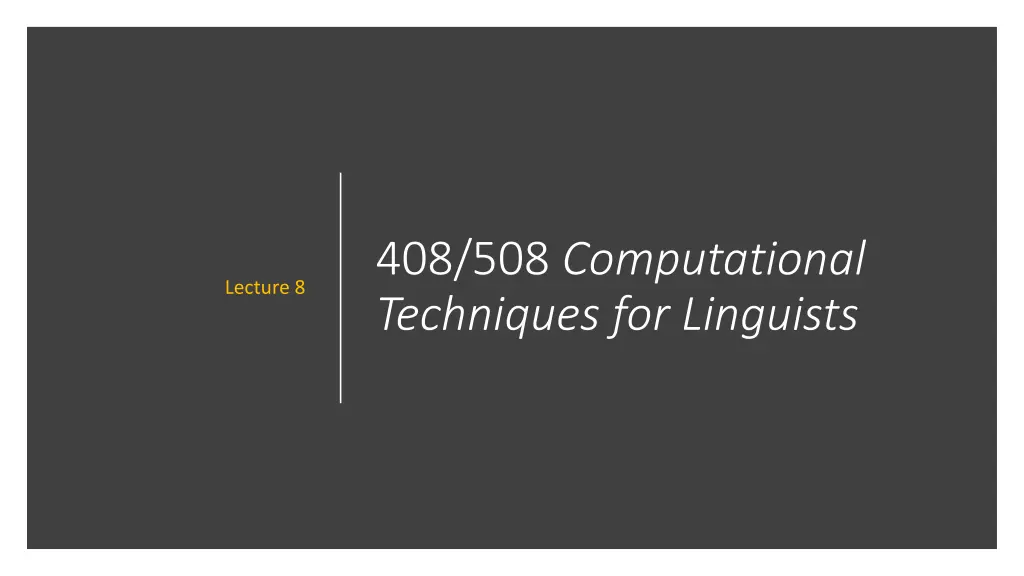
Computational Techniques for Linguists Lecture 8 Topics and Examples
Explore essential topics such as file permissions, shell scripting, and shell arithmetic covered in Lecture 8 of Computational Techniques for Linguists. Learn how to work with shell scripts, utilize the `bc` command for arithmetic operations, and apply advanced concepts like command substitution. Enhance your understanding of computational tools for linguistic analysis through hands-on examples and explanations.
Download Presentation

Please find below an Image/Link to download the presentation.
The content on the website is provided AS IS for your information and personal use only. It may not be sold, licensed, or shared on other websites without obtaining consent from the author. If you encounter any issues during the download, it is possible that the publisher has removed the file from their server.
You are allowed to download the files provided on this website for personal or commercial use, subject to the condition that they are used lawfully. All files are the property of their respective owners.
The content on the website is provided AS IS for your information and personal use only. It may not be sold, licensed, or shared on other websites without obtaining consent from the author.
E N D
Presentation Transcript
408/508 Computational Techniques for Linguists Lecture 8
Today's Topics 1. a note on file permissions 2. bc (command) 3. a note on positional parameters 4. Homework 4 a shell script program for you to write
Running shell scripts number 1 1 0 1 0 0 1 0 0 Command: chmod permissionsfilename permissions: e.g. u+x (user add execute) or a number Recall everything is binary: 110 = 6, 100 = 4 644 = 110100100 (3 groups of binary)
Shell Arithmetic: use command bc instead shell arithmetic, e.g. ((z= x+y)), is integer only. What if you needed floating point numbers? man bc command brings up this page bc runs interactively bc l loads the math library first
command bc Examples: we know tan( /4) = 1, so tan-1(1) = /4 function a(radians) computes arctan when bc -l is used Control-D (EOF) to exit bc ( /4 in radians = 45 ) using echo and pipe into bc
command bc Example: we know tan( /4) = 1, so tan-1(1) = /4 function a(radians) computes arctan when bc -l is used From man bc: the following [Terminal command] will assign the value of "pi" to the shell variable pi. ( /4 in radians = 45 ) $(command) is a modern synonym for `command` (` is backtick, not ') which stands for command substitution; it means run command and put its output here (see next slide).
command bc https://www.gnu.org/software/bash/manual/html_node/Command-Substitution.html#Command-Substitution pi=$(echo "scale=10; 4*a(1)" | bc -l) pi=`echo "scale=10; 4*a(1)" | bc -l`
command bc https://www.gnu.org/software/bash/manual/html_node/Bash-Builtins.html#index-echo pi=$(echo "scale=10; 4*a(1)" | bc -l) send string as a file of one line as input to bc
command bc pi is a bash shell variable here spacebar to get out of more
command bc scale variable in bc:
command bc scale
Math constant e https://www.mathsisfun.com/numbers/e-eulers-number.html
command bc Output base (obase) variable: obase=2 obase=16 (hexadecimal) 0..9,A..F Recall: control-D to exit (binary)
Positional Parameters Inside a shell script, these variables have values: $1: first parameter $2: 2ndparameter and so on $#: # of parameters Output: bash test.sh Number of parameters: 0 bash test.sh 45 Number of parameters: 1 1st parameter: 45 bash test.sh 45 56 Number of parameters: 2 Program on webpage test.sh: #!/bin/bash echo "Number of parameters: $#" if [ $# -eq 1 ]; then echo "1st parameter: $1" fi or do chmod u+x test.sh Run using: ./test.sh
If-test Spaces are important! test2.sh $ bash test2.sh 1 2 Number of parameters: 2 test2.sh: line 3: [2: command not found $
If-test Note the spaces between the [ ] !
If-test https://www.gnu.org/software/bash/manual/bash.html if [[ condition ]] (newer test: older[ ] suppported) $ bash test3.sh 1 Number of parameters: 1 1st parameter: 1 $ bash test3.sh 10 Number of parameters: 1 $ see previous slide, plus pattern matching, e.g. regex =~ [[ $# -eq 1 && $1 -lt 10 ]] vs. [ $# -eq 1 ] && [ $1 -lt 10 ]
Homework 4 Let s write a simple shell-script BMI calculator solicit input from the terminal (using read) or from the command line ($1 $2) arguments try the metric one first
Homework 4 You can use if-test, bc (from this lecture), and shell scripting to build your program Submit your shell script and screenshots of your runs To get you started, let's play on the command line first: your instructor weights 72kg and is 1.72 meters tall ((bmi = 72 / (1.72 * 1.72))) echo $bmi won't work: why?
Homework 4 One approach is to scale height in cm instead of meters: ((bmi = 72 / (172 * 172))) echo $bmi how to scale it if we use cm instead of m? 100 cm in a meter, multiply by what?
Homework 4 Instead of scaling to integer, we could pipe numbers to bc directly: or use variables:
Homework 4 After you figure out how to do on the command line, put it in a shell script, and try to add the following three embellishments: 1. accept either command line arguments or read from the terminal if they re missing 2. recall read p "Enter : " variablename if [ $# -ne N ]; then N = number of command line arguments.
Homework 4 2. print the weight status message according to the following table: 3. modify the calculator to accept input in both metric and traditional units make sure you supply examples of your program working! no command line arguments! read -p command line arguments!
Homework 4 Instructions: email sandiway@arizona.edu submit everything in one PDF file! subject of email: 408/508 Homework 4 your name cite any discussion or source due date: next Sunday by midnight
